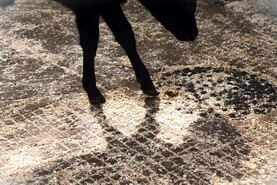Recently, a dairy farmer brought in five calves to my surgery that were coughing, two of which were in considerable respiratory distress. They belonged to a batch of 16 which were the last of his late calves.
He told me that the older calves were also coughing a good bit, though they were all eating meal and appeared healthy enough. Despite treatment, two of the calves died and I organised for a post-mortem examination to be carried out in the Regional Veterinary Laboratory in Kilkenny.
The lab rang me that same afternoon saying there was a very heavy burden of lungworm in the calf, the heaviest she had seen this year.
The farmer had already treated this batch with fenbendazole, one of the white drenches, and they were starting to improve. The older calves had been dosed with an ivermectin injection and while they were in good form, they were still coughing a bit.
We were worried that there might be some anthelmintic resistance to the ivermectin product, which we are going to investigate further. In the meantime, he has decided to give this older batch a second dose with fenbendazole.
Interestingly, the late calves were only out for two weeks when this problem arose.
They were turned out into a paddock that had been used previously for the older calves. Before that, the paddock had been grazed by the milking cows.
For the young calves to die from hoose after only two weeks out, there must have been a very high level of infection on the pasture.
The cows would have left a small amount of hoose larvae behind. These would have been multiplied hugely by the early calves. Coupled with this, the weather was warm and humid, which is ideal for the spread of hoose at this time of year.
The grass was also shooting out, which helps increase the ingestion of hoose larvae.
In the Knowledge Transfer herd health plans, which we have just completed recently, it regularly came up that a low-risk or clean pasture was recommended for turning out calves. This outbreak showed that this is good advice.
Shane McGuckin is a partner in The Vet Hospital, a five-person mixed practice in Gorey and part of XLVets, a group of progressive practices working together for a better future for agriculture and veterinary in Ireland. For more, go to www.xlvets.ie.






 This is a subscriber-only article
This is a subscriber-only article









SHARING OPTIONS: